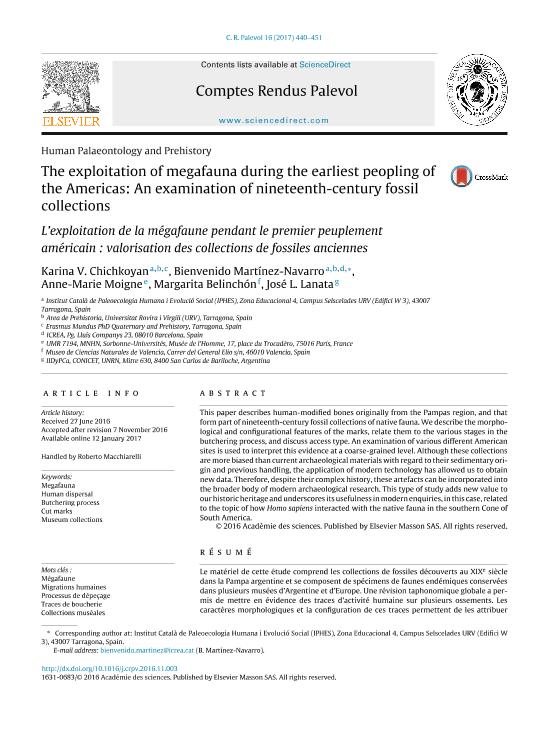Artículo
This paper describes human-modified bones originally from the Pampas region, and that form part of nineteenth-century fossil collections of native fauna. We describe the morphological and configurational features of the marks, relate them to the various stages in the butchering process, and discuss access type. An examination of various different American sites is used to interpret this evidence at a coarse-grained level. Although these collections are more biased than current archaeological materials with regard to their sedimentary origin and previous handling, the application of modern technology has allowed us to obtain new data. Therefore, despite their complex history, these artefacts can be incorporated into the broader body of modern archaeological research. This type of study adds new value to our historic heritage and underscores its usefulness in modern enquiries, in this case, related to the topic of how Homo sapiens interacted with the native fauna in the southern Cone of South America. Le matériel de cette étude comprend les collections de fossiles découverts au XIXe siècle dans la Pampa argentine et se composent de spécimens de faunes endémiques conservées dans plusieurs musées d’Argentine et d’Europe. Une révision taphonomique globale a permis de mettre en évidence des traces d’activité humaine sur plusieurs ossements. Les caractères morphologiques et la configuration de ces traces permettent de les attribuer à des étapes du processus de boucherie. Ces collections fossiles souffrent, plus que tout autre matériel archéologique, de nombreux biais liés à leur origine sédimentaire et à leur historique. Néanmoins, les observations microscopiques et l’étude des traces à partir des données de scanner surfaciques ont permis d’argumenter et de confirmer ces interprétations. Malgré leur histoire compliquée, ces collections peuvent ainsi être intégrées à un corpus archéologique et étudiées selon ce nouvel axe de recherche. Ce type d’étude permet de revaloriser un patrimoine historique en montrant l’intérêt de ces collections dans des problématiques actuelles telles que la question de l’interaction d’Homo sapiens avec les mégafaunes endémiques du cône austral d’Amérique du Sud.
The exploitation of megafauna during the earliest peopling of the Americas: An examination of nineteenth-century fossil collections
Título:
L’exploitation de la mégafaune pendant le premier peuplement américain : valorisation des collections de fossiles anciennes
Chichkoyan, Karina Vanesa ; Martínez Navarro, Bienvenido; Moigne, Anne Marie; Belinchón, Margarita; Lanata, Jose Luis
; Martínez Navarro, Bienvenido; Moigne, Anne Marie; Belinchón, Margarita; Lanata, Jose Luis
 ; Martínez Navarro, Bienvenido; Moigne, Anne Marie; Belinchón, Margarita; Lanata, Jose Luis
; Martínez Navarro, Bienvenido; Moigne, Anne Marie; Belinchón, Margarita; Lanata, Jose Luis
Fecha de publicación:
06/2017
Editorial:
Elsevier Masson
Revista:
Comptes Rendus Palevol
ISSN:
1631-0683
Idioma:
Inglés
Tipo de recurso:
Artículo publicado
Clasificación temática:
Resumen
Palabras clave:
Butchering Process
,
Cut Marks
,
Human Dispersal
,
Megafauna
,
Museum Collections
Archivos asociados
Licencia
Identificadores
Colecciones
Articulos(IIDYPCA)
Articulos de INST. DE INVESTIGACIONES EN DIVERSIDAD CULTURAL Y PROCESOS DE CAMBIO
Articulos de INST. DE INVESTIGACIONES EN DIVERSIDAD CULTURAL Y PROCESOS DE CAMBIO
Citación
Chichkoyan, Karina Vanesa; Martínez Navarro, Bienvenido; Moigne, Anne Marie; Belinchón, Margarita; Lanata, Jose Luis; The exploitation of megafauna during the earliest peopling of the Americas: An examination of nineteenth-century fossil collections; Elsevier Masson; Comptes Rendus Palevol; 16; 4; 6-2017; 440-451
Compartir
Altmétricas



